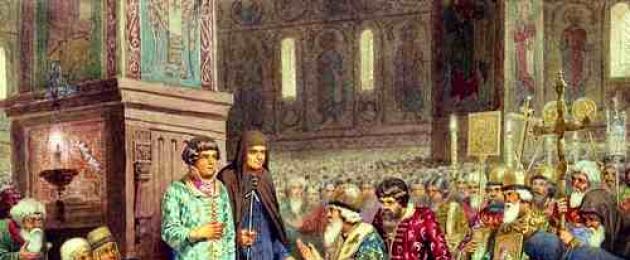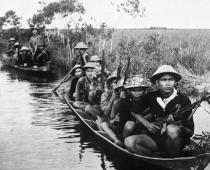Mikhail Fedorovich Romanov (born 12 (22) July 1596 - death 13 (23) July 1645) - Sovereign, Tsar and Grand Duke of All Russia. Board from February 21 (March 3), 1613 - to July 13 (23), 1645
During the Troubles
The father of Mikhail Fedorovich was Fyodor Nikitich Romanov, who later became Patriarch Filaret, married to Xenia Ivanovna Shestova, from an humble family. Their son Mikhail was born on July 12, 1596.
1601 - Boris Godunov tonsured Fyodor Nikitich Romanov as a monk with the name Filaret and exiled him to the St. Sophia Anthony Monastery, and tonsured his wife Xenia under the name Martha and exiled to Zaonezhye, to the Yegoryevsky churchyard of the Tolvui volost.
Mikhail Fedorovich ended up with his aunt Martha Nikitichnaya Cherkasskaya on Beloozero, from 1603 he lived in Klin (the Romanovs' ancestral patrimony), from 1605 - with his mother.
The first impostor elevated Filaret to the rank of Metropolitan of Rostov. His family was reunited and almost until the end of 1608 lived together, and at the time when Filaret was in his honorable captivity - in Moscow.
1610 - Filaret and Prince Golitsyn were sent to the Poles, who did not let him go, and for the next 9 years Mikhail did not see his father. The future tsar and his mother were detained in the Moscow Kremlin and released from captivity only in November 1612, when they retired to Kostroma, living either in their own house or in the Ipatiev Monastery.
Zemsky Sobor. Election to the kingdom
On February 21, 1613, the Zemsky Sobor elected Mikhail Fedorovich as tsar. On March 13, ambassadors from the Council arrived in Kostroma and the next day they were received at the Ipatiev Monastery. Nun Martha and her son resolutely refused to accept the proposal of the Council, mainly because, as the mother said, “her son has no idea of being a sovereign in such great glorious states; he is not in perfect years, but the people of the Moscow state of all ranks, because of their sins, were exhausted, giving their souls to the former sovereigns, they did not directly serve.
After negotiations that lasted six hours, mother and son, when they were threatened that God would punish them for the final ruin of the state, agreed to accept the election of Mikhail Fedorovich to the royal throne.
1613, July 11 - in the Assumption Cathedral of the Moscow Kremlin, the wedding to the kingdom of Mikhail Fedorovich took place. The Romanov dynasty began.
The beginning of the reign of the Romanovs

Xenia Ivanovna Shestova. The king's mother
The young and weak-willed king was unable to do without the firm support of his relatives. This was provided to him, and even excessively, by his mother, and upon his return from Polish captivity, by his father. Vladyka Filaret was a man of a tough and tough temper, but nun Martha was distinguished by an even tougher and more domineering character. “It was enough to look at her portrait,” wrote the historian S. F. Platonov, “at low eyebrows, stern eyes, a large, hooked nose, and most of all at mocking and at the same time imperious lips, in order to get an idea of her mind, strong character and will, but these signs say little about gentleness and kindness.
Having come to power, Mikhail Fedorovich was forced to start streamlining internal affairs and fighting external enemies - Sweden and Poland. In addition, many gangs of robbers calmly moved from one edge of the Russian land to another, robbed and committed excesses, completely ruining the Muscovite state.
The first task of the new government was to collect the treasury. The sovereign and the Zemsky Sobor sent letters everywhere with orders to collect taxes and state revenues, with requests for a loan for the treasury of money and everything that could be given. Particular attention was paid to the gangs of Cossacks and all other rabble. The struggle with Zarutsky was long, with the gang of which they were able to deal only in June 1614. And by the autumn of 1614, they dealt with the ataman Balovny and his gang on the upper reaches of the Volga. In the end, by 1616 they were able to weaken and disperse the most dangerous gang - Lisovsky.
The Zemsky Sobor of 1616 decided to levy the fifth money on all merchants and indicated to rich people what sums they needed to give to the treasury in order to wage war against external enemies. The Swedes owned Novgorod and the Vodskaya Pyatina and wanted to annex this region to Sweden. In addition, they demanded that Russia recognize Prince Philip as the Tsar of Moscow, to whom the Novgorodians had already sworn allegiance. But most of all, the Swedes were interested in preventing the Russians from reaching the Baltic Sea. Therefore, they willingly agreed to the mediation of England and Holland in the peace negotiations.
Negotiations were often interrupted, in the end, they ended in eternal peace on February 27, 1617 in Stolbov. The Swedes conceded Novgorod, Porkhov, Staraya Russa, Ladoga and Gdov to the Russians, and the Russians ceded the Primorsky Territory to the Swedes: Ivangorod, Yam, Koporye, Oreshek and Korela, while pledging to pay Sweden 20 thousand rubles. At the same time, the British, Dutch and Swedes secured important trading privileges for themselves.
It should be noted that because of these territories many years later it will participate in the Northern War. The domestic policy of the first tsar of the Romanov dynasty was still aimed at stabilizing life and centralizing power. He was able to bring harmony to the secular and spiritual society, restore agriculture and trade, which were destroyed during the Time of Troubles, establish the first factories in the state, and transform the tax system depending on the size of the land.
It should also be said about such innovations by Mikhail Romanov as the first census of the population and their property conducted in the state, which made it possible to stabilize the tax system, as well as encouraging the development of creative talents by the state. The tsar ordered to hire the artist John Deters and instructed him to teach painting to capable Russian students.

The call to the kingdom of Mikhail Fedorovich Romanov
Personal life
1616 - Tsar Mikhail Romanov, the Queen-nun Martha, in agreement with the boyars, arranged a bridesmaid's bride, it was fitting for the tsar to marry and show the rightful heir to the power, so that there would be no troubles and unrest. It is curious that these brides were originally a fiction - the mother had already chosen a future wife for the sovereign from the noble Saltykov family. However, Mikhail Fedorovich confused her plans - he chose his bride himself. She was the hawthorn Maria Khlopova, but she was not destined to become a queen. In anger, the Saltykovs began to secretly poison the girl's food, and because of the symptoms of the disease, she was recognized as an unsuitable candidate. However, the sovereign uncovered the boyar intrigues and exiled the Saltykov family.
But the character of the king was too soft to insist on a wedding with Maria Khlopova. He married foreign brides. Although they agreed to marriage, but only on the condition of maintaining the Catholic faith, which turned out to be unacceptable for Russia. As a result, the well-born Princess Maria Dolgorukaya became the sovereign's wife. But just a few days after the wedding, she fell ill and died soon after. The people called this death a punishment for insulting Maria Khlopova, and historians do not exclude a new poisoning.
1626 - the tsar was in his thirtieth year and he was a childless widower. Again, the bride was organized, again behind the scenes the future queen was chosen in advance, and again Mikhail Fedorovich Romanov showed self-will. They chose the daughter of the Meshchovsky nobleman Evdokia Streshneva, who was not even a candidate and did not take part in the bride, but arrived as a servant of one of the girls. The wedding was played very modestly, the bride was protected from assassination by all possible means, and when she showed that she was not interested in the politics of Mikhail Romanov, all the intriguers fell behind the tsar's wife.
In family life, Mikhail Fedorovich and Evdokia Lukyanovna were relatively happy. The family couple became the founders of the Romanov dynasty and produced 10 children, although 6 of them died in infancy. The future Tsar Alexei Mikhailovich was the third child and the first son of the ruling parents. In addition to him, three daughters of Mikhail Romanov survived - Irina, Tatyana and Anna. Evdokia Streshneva herself, in addition to the main duty of the queen - the birth of heirs, was engaged in charity work, helping churches and poor people, building temples and leading a pious life.

Mikhail Fedorovich and Evdokia Streshneva
Death
Mikhail Fedorovich Romanov was often ill in the last months of his life. Walking and riding had a tiring effect on him, his body weakened from a sedentary lifestyle. Apparently, the failure in arranging the fate of his eldest daughter also had an effect on him: the refusal of the Danish prince dealt him a heavy blow.
1645, July 12 - on the day of his name day, Mikhail Romanov, having overcome his malaise, got out of bed and went to church. But there he had an attack of suffocation. The king was transferred to the chambers. But by evening he got worse. He groaned and complained of severe pain in his heart. He ordered to call the queen and son, 16-year-old Alexei. He blessed him for the kingdom, confessed to the patriarch, and at the third hour of the night he died quietly.
Foreign doctors who treated the Moscow Tsar explained that his illness came from “many sitting”, from cold drinking and melancholy ...
Queen Evdokia was able to outlive her royal husband by only a few months. The only son of Tsar Mikhail, 16-year-old Alexei, became the successor of the Romanov family: a year before his death, the autocrat declared him publicly the heir to the royal throne.
Thus, the reign of the first tsar of the Romanov family ended. Tsar Mikhail Romanov, the founder of the dynasty, who shared power for 14 years with his father, an involuntary monk and patriarch, came to power in a completely democratic way and laid the foundation for a long journey. During his reign, the Muscovite state was able to heal the severe wounds caused by the Time of Troubles, so much so that the reign of Alexei Mikhailovich could become quite successful for Russia both in internal and external affairs.
From the significant cases of the reign of Mikhail Fedorovich Romanov
1619 - the foundation of the Yenisei prison on the Yenisei River - the center of the Russian development of Eastern Siberia.
1620 - the foundation of the Pharmaceutical Order - the first state medical institution.
Construction in 1624–1625 Spasskaya (Frolovskaya) Tower of the Moscow Kremlin by Russian architect B. Ogurtsov.
1627 - expansion of the powers of elected zemstvo authorities and courts by limiting the power of governors.
1628 - the foundation of the Krasnoyarsk prison on the Yenisei River.
1630 - the construction of the first ironworks in the Trans-Urals near Irbit.
1631 - Bratsk prison was founded in Siberia.
1632, February 19 - a charter of the tsar to the Dutch merchant A. Vinius for the construction of factories near Tula for casting cannons, boilers, forging "boards and rods", with exemption from duties and dues for 10 years. 1636, March 14 - the first iron was obtained at the Vinius plant.
1632 - Lena Ostrog (later Yakutsk) was founded on the Lena River.
1633 - the establishment of the Greek-Latin patriarchal school by Patriarch Philaret in the Miracle Monastery in the Kremlin.
1633 - discovery of copper deposits in the upper reaches of the Kama River and the construction of the first Pyskorsky copper smelter.
1634 - the publication in Moscow of the "Primer of the Slovene language, that is, the beginning of teaching for children" by V.F. Burtsov-Protopopov - the first printed textbook published in Russia.
1635–1636 - construction in Moscow by architects A. Konstantinov, B. Ogurtsov, L. Ushakov and T. Sharutin of the Kremlin Terem Palace.
1636 - the foundation of Simbirsk and Tambov.
1636 - the beginning of the construction of defensive structures of the Belgorod "notch line".
1639 - the oath of allegiance to the Russian tsar of the Kakhetian king Teimuraz I.
1640 - construction of the Oblique Ostrog (future Okhotsk) on the coast of the Sea of Okhotsk.
The first tsar of the Romanov dynasty died on July 12, 1645 and was buried in the Archangel Cathedral of the Moscow Kremlin.
- In contact with 0
- Google Plus 0
- OK 0
- Facebook 0








